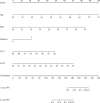Risk Factor Analysis and Construction of a Prognostic Model after Percutaneous Coronary Intervention in Patients with Chronic Total Occlusion
- PMID: 35154363
- PMCID: PMC8825273
- DOI: 10.1155/2022/9902380
Risk Factor Analysis and Construction of a Prognostic Model after Percutaneous Coronary Intervention in Patients with Chronic Total Occlusion
Abstract
Methods: The clinical data of 82 patients with CTO who underwent PCI in Lianshui County People's Hospital were collected in this study. The patients were divided into training set (n = 54) and validation set (n = 28) by random sampling method. Statistical difference test was performed for clinical features of patients. Univariate and multivariate Cox regression analyses were performed to determine the risk factors affecting progression of CTO. Nomogram was used to construct a prediction model for disease progression. C-index was calculated, and the accuracy of the model was tested by calibration curve.
Results: No statistically significant differences were incorporated in baseline characteristics of included patients (p > 0.05). There were 25 patients with adverse cardiac events during follow-up in the training set and 13 in the validation set. The results of multivariate Cox regression analysis demonstrated that the important factors affecting postoperative disease progression mainly came down to age, BMI, diabetes, creatinine clearance rate, and left ventricular fraction < 40%. A nomogram was constructed and C-index was calculated. The calibration curve was then used to evaluate and predict risk model of disease progression. The result showed an internal validation C-index of 0.6219 and an external validation C-index of 0.6453, which indicated the good prediction performance of the model.
Conclusion: The risk of disease progression in CTO patients treated with PCI can be effectively predicted by the risk model constructed in this study, which opens up a great possibility for enriching the means of predicting the prognosis of these patients in clinical practice.
Copyright © 2022 Xia Zhao et al.
Conflict of interest statement
No potential conflict of interest was reported by the authors.
Figures



References
-
- Allahwala U. K., Ward M. R., Brieger D., Weaver J. C., Bhindi R. Indications for percutaneous coronary intervention (PCI) in chronic total occlusion (CTO): have we reached a DECISION or do we continue to EXPLORE after EURO-CTO? Heart, Lung & Circulation . 2019;28(10):1484–1489. doi: 10.1016/j.hlc.2019.03.014. - DOI - PubMed
MeSH terms
LinkOut - more resources
Full Text Sources
Miscellaneous

